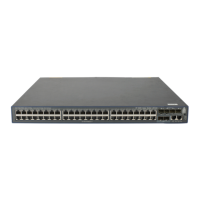91
Ste
Command
Remarks
2. Specify a set of domain name
delimiters for 802.1X users.
dot1x domain-delimiter string
Optional.
By default, only the at sign (@)
delimiter is supported.
NOTE:
If you confi
ure the access device to include the domain name in the username sent to the RADIUS server,
make sure the domain delimiter in the username can be recognized by the RADIUS server. For username
format configuration, see the user-name-format command in
Security Command Reference
.
Displaying and maintaining 802.1X
Task Command Remarks
Display 802.1X session
information, statistics, or
configuration information of
specified or all ports.
display dot1x [ sessions | statistics ]
[ interface interface-list ] [ | { begin | exclude
| include } regular-expression ]
Available in any view
Clear 802.1X statistics.
reset dot1x statistics [ interface interface-list ] Available in user view
802.1X authentication configuration example
Network requirements
As shown in Figure 29, the access device performs 802.1X authentication for users that connect to port
GigabitEthernet 1/0/1. Implement MAC-based access control on the port, so the logoff of one user does
not affect other online 802.1X users.
Use RADIUS servers to perform authentication, authorization, and accounting for the 802.1X users. If
RADIUS authentication fails, perform local authentication on the access device. If RADIUS accounting
fails, the access device logs the user off.
Configure the host at 10.1.1.1/24 as the primary authentication and accounting servers, and the host at
10.1.1.2/24 as the secondary authentication and accounting servers. Assign all users to the ISP domain
aabbcc.net, which accommodates up to 30 users.
Configure the shared key as name for packets between the access device and the authentication server,
and the shared key as money for packets between the access device and the accounting server.

